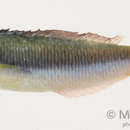Diagnostic Description
provided by Fishbase
Juveniles easily identified by the color pattern and rounded snout. Males become brightly colored and head usually green with a yellow band following on the body (Ref. 48636). Head naked, no scales dorsally on opercle. Initial phase with a broad blackish stripe from snout through eye to caudal-fin base (Ref 9823).
Life Cycle
provided by Fishbase
Oviparous, distinct pairing during breeding (Ref. 205).
Morphology
provided by Fishbase
Dorsal spines (total): 8; Dorsal soft rays (total): 13; Analspines: 3; Analsoft rays: 10 - 11
Trophic Strategy
provided by Fishbase
Occurs inshore (Ref. 75154).
Biology
provided by Fishbase
Occurs in aggregations over shallow lagoon and seaward reefs (Ref. 9710) and on reef flats (Ref. 9823). Feeds mainly on crustacean zooplankton (Ref. 1602). Spawns at dusk above reefs (Ref. 90102). Rarely marketed (Ref. 2334).
- Recorder
- Estelita Emily Capuli
Importance
provided by Fishbase
fisheries: of no interest; aquarium: commercial
- Recorder
- Estelita Emily Capuli
分布
provided by The Fish Database of Taiwan
分布於印度-太平洋區,由索馬利亞、南非到萊恩、馬貴斯及土木土群島等,北至日本、台灣海域,南至澳洲、羅得豪島及紐西蘭等。台灣除西部外,各地岩礁海域皆有分布。
利用
provided by The Fish Database of Taiwan
中小型之隆頭魚,體色鮮豔,是適合水族觀賞的魚類,可食用,但個體小,較無食用價值。
描述
provided by The Fish Database of Taiwan
體稍長且側扁。吻部短;上下頜具一列尖齒,前方各具
2犬齒,無後犬齒。體被大形圓鱗,頭部無鱗,背鰭前之胸部被較小鱗,頸部裸出;腹鰭具鞘鱗。D.
VIII, 13;A. III, 10-11;G.R.
16-19;尾鰭截形,或略成凹型,成魚時為半月型。體色因魚齡大小與性別而差別極大,雌魚自吻部至尾鰭基部具一黑色寬帶;色帶上方之頭與體綠色,下方白色;尾鰭白色,上下鰭緣橙色。雄魚紅色,體側具綠色垂直短紋;頸背及體側前端黃色;頭藍綠色;頰部與鰓蓋具二條金黃色斜紋;胸鰭黃色,外側具黑緣之藍斑。
棲地
provided by The Fish Database of Taiwan
主要棲息於潮間帶到水深約15公尺的珊瑚礁海域。成魚通常行一夫多妻的群居生活,在淺珊瑚叢或礁盤上棲息或活動。成群的小魚則喜在軟、硬珊瑚礁表面巡游,偶爾也游到離礁盤2公尺的水層中攝食。主要攝取浮游動物為生。
Thalassoma amblycephalum
provided by wikipedia EN
Thalassoma amblycephalum, the blunt-headed wrasse, blue-headed wrasse, blue-headed zoe, moon wrasse, paddle-fin wrasse or two-tone wrasse,[3] is a species of wrasse native to the Indian Ocean and the western Pacific Ocean. It is a reef inhabitant, being found in schools at depths from 1 to 15 m (3.3 to 49.2 ft). This species can reach 16 cm (6.3 in) in standard length. It can also be found in the aquarium trade.[2]
References

- license
- cc-by-sa-3.0
- copyright
- Wikipedia authors and editors
Thalassoma amblycephalum: Brief Summary
provided by wikipedia EN
Thalassoma amblycephalum, the blunt-headed wrasse, blue-headed wrasse, blue-headed zoe, moon wrasse, paddle-fin wrasse or two-tone wrasse, is a species of wrasse native to the Indian Ocean and the western Pacific Ocean. It is a reef inhabitant, being found in schools at depths from 1 to 15 m (3.3 to 49.2 ft). This species can reach 16 cm (6.3 in) in standard length. It can also be found in the aquarium trade.
- license
- cc-by-sa-3.0
- copyright
- Wikipedia authors and editors
Description
provided by World Register of Marine Species
Occurs in aggregations over shallow reefs and on reef flats (Ref. 9823). Feeds mainly on crustacean zooplankton (Ref. 1602). Rarely marketed.
Froese, R. & D. Pauly (Editors). (2023). FishBase. World Wide Web electronic publication. version (02/2023).
- license
- cc-by-4.0
- copyright
- WoRMS Editorial Board

